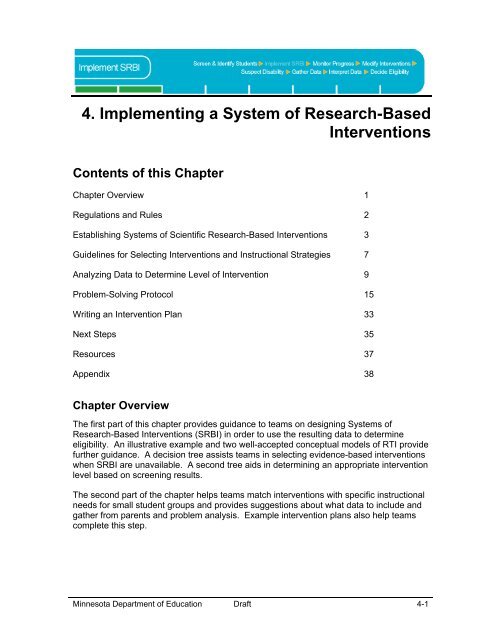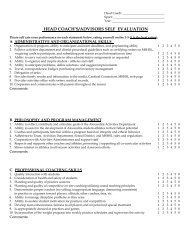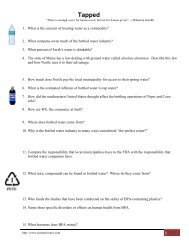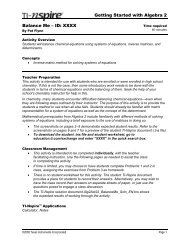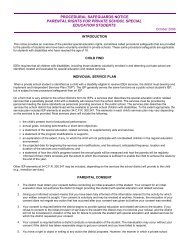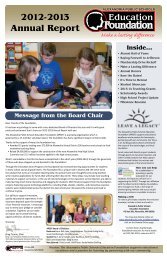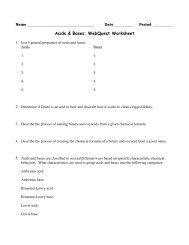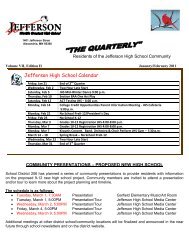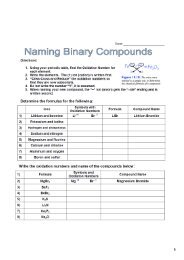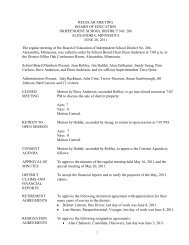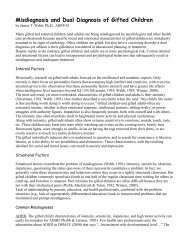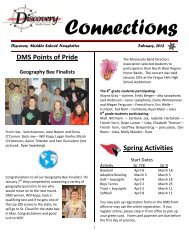Chapter 4 - Implementing a System of Research-based Interventions
Chapter 4 - Implementing a System of Research-based Interventions
Chapter 4 - Implementing a System of Research-based Interventions
You also want an ePaper? Increase the reach of your titles
YUMPU automatically turns print PDFs into web optimized ePapers that Google loves.
4. <strong>Implementing</strong> a <strong>System</strong> <strong>of</strong> <strong>Research</strong>-Based<br />
<strong>Interventions</strong><br />
Contents <strong>of</strong> this <strong>Chapter</strong><br />
<strong>Chapter</strong> Overview 1<br />
Regulations and Rules 2<br />
Establishing <strong>System</strong>s <strong>of</strong> Scientific <strong>Research</strong>-Based <strong>Interventions</strong> 3<br />
Guidelines for Selecting <strong>Interventions</strong> and Instructional Strategies 7<br />
Analyzing Data to Determine Level <strong>of</strong> Intervention 9<br />
Problem-Solving Protocol 15<br />
Writing an Intervention Plan 33<br />
Next Steps 35<br />
Resources 37<br />
Appendix 38<br />
<strong>Chapter</strong> Overview<br />
The first part <strong>of</strong> this chapter provides guidance to teams on designing <strong>System</strong>s <strong>of</strong><br />
<strong>Research</strong>-Based <strong>Interventions</strong> (SRBI) in order to use the resulting data to determine<br />
eligibility. An illustrative example and two well-accepted conceptual models <strong>of</strong> RTI provide<br />
further guidance. A decision tree assists teams in selecting evidence-<strong>based</strong> interventions<br />
when SRBI are unavailable. A second tree aids in determining an appropriate intervention<br />
level <strong>based</strong> on screening results.<br />
The second part <strong>of</strong> the chapter helps teams match interventions with specific instructional<br />
needs for small student groups and provides suggestions about what data to include and<br />
gather from parents and problem analysis. Example intervention plans also help teams<br />
complete this step.<br />
Minnesota Department <strong>of</strong> Education Draft 4-1
<strong>Chapter</strong> 4 <strong>Implementing</strong> a <strong>System</strong> <strong>of</strong> <strong>Research</strong>-Based <strong>Interventions</strong><br />
Regulations and Rules<br />
Note: Regulations, statutes, and rules form the basis for legal compliance, and are<br />
provided below to help teams understand what the law requires.<br />
Minnesota Rule 3525.1341 Subpart 4 requires consistency between the team's plan<br />
for identifying a child with a specific learning disability and its Total Special Education<br />
<strong>System</strong> (TSES) plan. The team must implement its interventions consistent with that plan.<br />
Minnesota Rule also dictates that teams include the following in their TSES plan:<br />
<br />
<br />
Specific systems <strong>of</strong> SRBI approach.<br />
Timelines for progression through the<br />
intervention model.<br />
Adequate progress after an<br />
appropriate period is not defined<br />
within the federal regulations for the<br />
following reason:<br />
<br />
<br />
<br />
SRBI for each content area and grade.<br />
Proposed teacher training for systems <strong>of</strong> SRBI<br />
implementation.<br />
Strategies for increasing student achievement.<br />
Minnesota Statute section 125A.56 requires that<br />
teams provide two interventions prior to referral for<br />
evaluation. View complete legal language on the<br />
Minnesota state Website.<br />
Subdivision 1. Requirement. (a) Before a pupil is<br />
referred for a special education evaluation, the team<br />
must conduct and document at least two<br />
instructional strategies, alternatives, or interventions<br />
using a system <strong>of</strong> scientific, research-<strong>based</strong><br />
instruction and intervention in academics or<br />
behavior, <strong>based</strong> on the pupil's needs, while the pupil<br />
is in the regular classroom. The pupil's teacher must<br />
“The Federal Department <strong>of</strong><br />
Education felt the meaning will vary<br />
depending on the specific<br />
circumstances in each case. There<br />
may be legitimate reasons for<br />
varying timeframes to seek parental<br />
consent for evaluation; however,<br />
they also believe that teams will<br />
know if an intervention is not working<br />
in less than 90 days. In general, it is<br />
not acceptable for an LEA to wait<br />
several months to conduct an<br />
evaluation or seek parental consent<br />
for an initial evaluation. If, through<br />
monitoring efforts, the state<br />
determines there is a pattern or<br />
practices <strong>of</strong> delaying evaluations, it<br />
could raise questions as to whether<br />
the LEA is within compliance.”<br />
--OSEP guidance Jan 1, 2007<br />
document the results. A special education evaluation team may waive this requirement<br />
when it determines the pupil's need for the evaluation is urgent. This section may not be<br />
used to deny a pupil's right to a special education evaluation.<br />
Statute also requires that interventions meet the criteria <strong>of</strong> “scientifically research-<strong>based</strong>”<br />
unless specific research-<strong>based</strong> interventions are not available for a given content area. For<br />
more information, see Determine if an Intervention is <strong>Research</strong>-<strong>based</strong> in the Appendix.<br />
View complete legal language on the Minnesota state Website.<br />
Minnesota Statute section 120B.12 Subd. 3. Intervention. For each student identified under<br />
subdivision 2, the team shall provide a reading intervention method or program to assist<br />
the student in reaching the goal <strong>of</strong> learning to read no later than the end <strong>of</strong> second grade.<br />
Minnesota Department <strong>of</strong> Education Draft 4-2
<strong>Chapter</strong> 4 <strong>Implementing</strong> a <strong>System</strong> <strong>of</strong> <strong>Research</strong>-Based <strong>Interventions</strong><br />
Establishing <strong>System</strong>s <strong>of</strong> Scientific <strong>Research</strong>-Based <strong>Interventions</strong><br />
(SRBI)<br />
Underlying effective implementation <strong>of</strong> systems <strong>of</strong> SRBI are key beliefs about how core<br />
curriculum and interventions should operate. Teams typically build their vision <strong>of</strong> effective<br />
systems on the following foundations:<br />
Staff, community members and parents believe that all students can learn. They<br />
engage in designing instruction to meet the needs <strong>of</strong> all students.<br />
Capacity exists to systematically maximize the effect <strong>of</strong> instruction for all students.<br />
Evidence-<strong>based</strong> instructional practices and materials are used at each support level<br />
and meet the needs <strong>of</strong> targeted learners including culturally diverse and special<br />
education populations.<br />
Instructional practices are differentiated to ensure that all students have access to the<br />
“critical” content or skills and experience instruction that is motivating and<br />
challenging.<br />
The focus <strong>of</strong> instruction is on alterable variables (instruction, curriculum, and<br />
environmental supports) that change trajectory <strong>of</strong> performance and achievement.<br />
Instructional supports are designed to accelerate learning and performance<br />
(remediation is insufficient).<br />
Mechanisms, processes, and procedures are in place to facilitate continuous<br />
improvement.<br />
Typically, systems <strong>of</strong> research-<strong>based</strong> interventions include tiers <strong>of</strong> support as described in<br />
Orientation to Specific Learning Disabilities Definition and Laws. Even though the<br />
Minnesota Department <strong>of</strong> Education uses three tiers <strong>of</strong> support to describe a framework,<br />
schools have the flexibility to determine their own conceptual model and structure <strong>of</strong><br />
support systems.<br />
Important: This chapter refers to support tiers as primary, secondary and tertiary<br />
prevention levels in order to stress that systems are not obliged by rules to require<br />
tiers. However, schools must determine the levels <strong>of</strong> support or tiers <strong>of</strong> intervention<br />
they will provide within their team system <strong>of</strong> SRBI and outline them in the TSES plan.<br />
For complete listing <strong>of</strong> requirements, see Minnesota Rule 3525.1341 Subpart 4. The<br />
linkage to primary, secondary, and tertiary levels <strong>of</strong> prevention comes from the<br />
extensive history <strong>of</strong> these terms in public health and community psychology.<br />
Minnesota Department <strong>of</strong> Education Draft 4-3
<strong>Chapter</strong> 4 <strong>Implementing</strong> a <strong>System</strong> <strong>of</strong> <strong>Research</strong>-Based <strong>Interventions</strong><br />
Building a <strong>System</strong> <strong>of</strong> Scientific <strong>Research</strong>-Based <strong>Interventions</strong><br />
Prior to building a system <strong>of</strong> interventions, school and<br />
teams should thoroughly evaluate their core curriculum and<br />
instructional practices at the primary level <strong>of</strong> prevention to<br />
ensure they are scientifically research-<strong>based</strong>, feasible, and<br />
that the critical areas <strong>of</strong> instruction are in place.<br />
Pilot site staff implementing a system <strong>of</strong> SRBI report that<br />
analysis <strong>of</strong> core practices is essential and highly discourage<br />
skipping analysis <strong>of</strong> core instructional practices in order to<br />
focus on selecting interventions. Teams that select<br />
interventions without thoroughly understanding the<br />
strengths and weaknesses <strong>of</strong> the core curriculum run a risk<br />
that selected interventions will not meet their long-term<br />
needs. Some districts have identified obvious gaps and<br />
selected secondary and tertiary supports to address those<br />
Minnesota Rule requires<br />
that teams specify the<br />
details <strong>of</strong> their systems<br />
used to generate data for<br />
eligibility determinations.<br />
For each content area,<br />
include related estimated<br />
timelines, and decision<br />
rules for how students will<br />
move through interventions<br />
(Minnesota Rule<br />
3525.1341)<br />
issues with an understanding that it is as an interim step. Simultaneously the team is<br />
working on training staff to systematically analyze alignment and implementation <strong>of</strong> core<br />
instruction.<br />
Illustrative Example<br />
Happy Valley school team began to use the Consumer’s Guide to Evaluating a Core<br />
Reading Program Grades K-3 (Simmons and Kame’enui) to help them analyze their<br />
reading practices prior to selecting interventions. This practice has since become an<br />
established precedent for other teams.<br />
To analyze core practices for adolescent literacy, see Model Secondary Plan, developed<br />
by the Minnesota Department <strong>of</strong> Education to assist secondary schools in revising their<br />
reading instructional practices.<br />
Additionally, school staff have found benefit in analyzing implementation <strong>of</strong> their core<br />
practices to understand if curriculum maps are current and are followed as designed. Once<br />
satisfied that core curriculum and instructional practices have been implemented correctly,<br />
school-wide data is used to identify performance gaps and lead to selection <strong>of</strong> appropriate<br />
interventions.<br />
After achievement data and core practices have been thoroughly reviewed, teams will<br />
have valuable data to assist in selecting appropriate research-<strong>based</strong> interventions. The<br />
SRBI research community developed two conceptual models <strong>of</strong> RTI: a standard treatment<br />
protocols for interventions, and a problem-solving approach. The table below includes<br />
definitions <strong>of</strong> both and the parameters in which they are effective.<br />
Minnesota Department <strong>of</strong> Education Draft 4-4
<strong>Chapter</strong> 4 <strong>Implementing</strong> a <strong>System</strong> <strong>of</strong> <strong>Research</strong>-Based <strong>Interventions</strong><br />
Table 4-1<br />
Intervention Protocols and Corresponding Problem-Solving Approaches<br />
Standard Treatment Protocol<br />
Problem-Solving Approach<br />
Includes interventions that researchers<br />
have validated as effective through<br />
experimental studies. A specific<br />
intervention protocol, that has evidence<br />
to support its effectiveness in improving<br />
student achievement, is provided to any<br />
student whose needs match what the<br />
intervention addresses.<br />
Standard treatment protocols are<br />
effective if they specify conditions, such<br />
as:<br />
What yields evidence <strong>of</strong> success.<br />
Number <strong>of</strong> minutes per day and days<br />
per week for interventions.<br />
Who should provide instruction,<br />
assumed knowledge and training?<br />
Specific skills to be taught.<br />
Materials to be used.<br />
How to monitor progress.<br />
Evidence <strong>of</strong> faithful implementation.<br />
Involves planning interventions for an<br />
individual student. The plan is created by an<br />
instructional team and implemented in the<br />
general education classroom (Mellard, 2008).<br />
This approach <strong>of</strong>ten combines interventions<br />
and accommodations to address multiple<br />
issues.<br />
Problem-solving models are effective if they<br />
include:<br />
A rigorous problem analysis that leads to<br />
understanding the gap between current<br />
and expected levels <strong>of</strong> learning and<br />
performance.<br />
A scientific approach to solving the<br />
problem with a focus on altering<br />
instruction, curriculum and classroom<br />
environment to improve performance.<br />
Scientifically tested interventions that have<br />
been proven effective by the field.<br />
A procedure for continuously monitoring<br />
student performance.<br />
Procedures for using information from a<br />
variety <strong>of</strong> sources that informs the decision<br />
to continue or modify the intervention in<br />
order to increase student performance.<br />
Quality practice and the need for efficiency suggests that the most effective and<br />
efficient means <strong>of</strong> matching interventions to student needs is an integration <strong>of</strong> problemsolving<br />
to identify which standard treatment protocols would be most appropriate. An<br />
alternative discussed in research indicates that selection <strong>of</strong> a standard treatment protocol<br />
in secondary prevention level supports (Tier 2 intervention) that addresses multiple critical<br />
areas <strong>of</strong> weakness, with a problem-solving approach applied to selection from a more<br />
targeted menu <strong>of</strong> tertiary prevention level supports (Tier 3 intervention), increases<br />
efficiency. (For more information on levels <strong>of</strong> support and standardized protocols see<br />
Mellard and Johnson, 2008; the National Center on Response to Intervention).<br />
Districts must devise systems with interventions and supports that provide the greatest<br />
likelihood <strong>of</strong> accelerating academic and behavioral learning and performance <strong>of</strong> those<br />
students identified as needing additional instruction. To assist districts in uniformly<br />
selecting the appropriate interventions, teams should establish guidelines for selecting the<br />
Minnesota Department <strong>of</strong> Education Draft 4-5
<strong>Chapter</strong> 4 <strong>Implementing</strong> a <strong>System</strong> <strong>of</strong> <strong>Research</strong>-Based <strong>Interventions</strong><br />
most appropriate intervention. Districts guidelines should be inclusive <strong>of</strong> circumstances<br />
under which a student should:<br />
Move into secondary supports.<br />
Skip to tertiary supports or evaluation for special education.<br />
Stay within a level <strong>of</strong> support (e.g., move from secondary decoding to secondary<br />
language comprehension intervention).<br />
Exit out <strong>of</strong> interventions.<br />
There is no assumption or statement in the Minnesota Rule specifying that students must<br />
move sequentially through the system. Instructional teams may decide to provide a student<br />
with the most intensive intervention available <strong>based</strong> on the significance and the need. The<br />
selected supplemental instruction should have the greatest likelihood <strong>of</strong> reducing the gaps<br />
in skills.<br />
Illustrative Example<br />
To prevent a mismatch between students' needs and available intervention supports, Lake<br />
Woebegone elementary has established guidelines for their continuum <strong>of</strong> supports.<br />
Secondary Supports: Early Intervention Reading, Read Well and Language! —small<br />
group instruction in letter recognition and language skills appropriate for students<br />
performing between the 26 th to 40 th percentile in letter recognition and language skills.<br />
Tertiary Supports: Reading Recovery—intensive one-to-one instruction in letter<br />
recognition and language skills appropriate for students performing between the 11 th to<br />
25 th percentile in letter recognition and language skills.<br />
First-graders performing between the 11 th and 25 th percentile in letter recognition and<br />
language skills receive Reading Recovery for 12 weeks. First-graders performing between<br />
the 26 th and 40 th percentiles receive Early Intervention Reading and Language! intervention<br />
in 6-week cycles.<br />
Although Reading Recovery would typically be considered a tertiary intervention, the team<br />
has determined through research and pilot data that the intervention is most successful for<br />
students performing in the 11 th -26 th percentile range. Additional analysis <strong>of</strong> team data has<br />
led to the guideline for moving students back to secondary supports if students do not<br />
respond or need continued intervention beyond Reading Recovery.<br />
For districts building their systems <strong>of</strong> SRBI or those selecting pre-referral<br />
interventions, the variables that are important to consider when differentiating between<br />
levels <strong>of</strong> intervention support include (Mellard, McKnight & Jordan, in press):<br />
Size <strong>of</strong> the instructional group.<br />
Immediacy and specificity <strong>of</strong> corrective feedback.<br />
Minnesota Department <strong>of</strong> Education Draft 4-6
<strong>Chapter</strong> 4 <strong>Implementing</strong> a <strong>System</strong> <strong>of</strong> <strong>Research</strong>-Based <strong>Interventions</strong><br />
Mastery requirements <strong>of</strong> content.<br />
Number <strong>of</strong> response opportunities within instructional session.<br />
Number <strong>of</strong> transitions among contents or classes.<br />
Specificity and focus <strong>of</strong> instructional goals covered each session.<br />
Frequency with which the intervention is delivered in a week.<br />
Duration or number <strong>of</strong> weeks in an intervention cycle.<br />
Minutes <strong>of</strong> intervention per session.<br />
The Changing Roles and Responsibilities <strong>of</strong> Screening and Intervention Staff<br />
The TSES plan requires an explanation <strong>of</strong> pr<strong>of</strong>essional development plans. Quality<br />
practices suggest that training should include administration and interpretation <strong>of</strong><br />
assessment results (screening and progress monitoring) as well as the intended<br />
research-<strong>based</strong> interventions. To ensure clarity for parents and staff providing service, it<br />
is also recommended that the description <strong>of</strong> each pr<strong>of</strong>essional’s role in the intervention<br />
process be clearly articulated.<br />
If a related services specialist or special education teacher delivers an intervention,<br />
those responsible for selecting the intervention the student will participate in should<br />
explain to parents how the role <strong>of</strong> the selected interventionist differs from the role <strong>of</strong> a<br />
special education teacher delivering special education services. In some cases,<br />
licensure statutes or union contracts influence who can provide intervention services.<br />
In 2006, the International Reading Association convened a workgroup to explore how<br />
various pr<strong>of</strong>essionals could contribute to the intervention process. View New Roles in<br />
Response to Intervention: Creating Success for Schools and Children on the American<br />
Speech-Language-Hearing Association Website to learn more about the role <strong>of</strong> staff in<br />
improving the achievement <strong>of</strong> struggling students.<br />
Guidelines for Selecting <strong>Interventions</strong> and Instructional Strategies<br />
The body <strong>of</strong> scientific research-<strong>based</strong> interventions and instructional strategies continues<br />
to develop. In the event that scientific research-<strong>based</strong> interventions or instructional<br />
practices are lacking, or peer-reviewed research is not available, the following decision<br />
tree may be helpful in determining appropriate interventions:<br />
Minnesota Department <strong>of</strong> Education Draft 4-7
<strong>Chapter</strong> 4 <strong>Implementing</strong> a <strong>System</strong> <strong>of</strong> <strong>Research</strong>-Based <strong>Interventions</strong><br />
Figure 4-1. Decision Tree for Determining <strong>Interventions</strong>.<br />
For more information, read consumer guides in the What Works Clearinghouse and the<br />
Florida Center for Reading <strong>Research</strong> to evaluate if interventions are research-<strong>based</strong>.<br />
Minnesota Department <strong>of</strong> Education Draft 4-8
<strong>Chapter</strong> 4 <strong>Implementing</strong> a <strong>System</strong> <strong>of</strong> <strong>Research</strong>-Based <strong>Interventions</strong><br />
Effective interventions follow these quality practices:<br />
Taught as supplemental to core instruction; not a replacement <strong>of</strong> core instruction or<br />
a subtraction from core instructional time.<br />
Guided by and responsive to data on student progress.<br />
Motivate and engage the student.<br />
Address areas the student needs to learn, not just followed because it is the next<br />
lesson or task in the book.<br />
Intervention staff provide students with:<br />
o<br />
o<br />
o<br />
o<br />
<strong>Interventions</strong> as soon as the student shows a lag in developmental skills or<br />
knowledge critical to reading growth.<br />
<strong>Interventions</strong> that increase in intensity and focus as the gap between the<br />
desired level <strong>of</strong> performance and student level <strong>of</strong> performance widens.<br />
Opportunities for explicit and systematic instruction and practice with<br />
cumulative review to ensure mastery.<br />
Skillful instruction including good error correction procedures with many<br />
opportunities for immediate positive feedback and reward.<br />
Important: This is the end <strong>of</strong> guidance for building a system <strong>of</strong> scientific research-<strong>based</strong><br />
interventions. The next section covers how to take the information gained during systems<br />
<strong>of</strong> SRBI to determine the level <strong>of</strong> intervention for the student.<br />
Analyzing Data to Determine Level <strong>of</strong> Intervention<br />
Teams should establish a framework to assist in developing decision rules about what<br />
intervention is required given the results <strong>of</strong> screening. The decision tree in the figure below<br />
uses the 80-15-5 resource allocation model discussed in the research literature as a guide<br />
for determining the necessary level <strong>of</strong> intervention. <strong>System</strong>ic interventions should proceed<br />
when 20 percent or more <strong>of</strong> students require supplemental instruction.<br />
This rule should be applied to subgroups not just the total population to ensure that the<br />
core instruction is effective for culturally and linguistically diverse students. The decision<br />
tree shown below allows teams to skip to an individual level <strong>of</strong> problem-solving when<br />
problems are infrequent or rare. Read the figure from the upper left corner and follow the<br />
arrows that match the “yes” or “no” answers.<br />
Minnesota Department <strong>of</strong> Education Draft 4-9
<strong>Chapter</strong> 4 <strong>Implementing</strong> a <strong>System</strong> <strong>of</strong> <strong>Research</strong>-Based <strong>Interventions</strong><br />
Figure 4-2. Level <strong>of</strong> Problem Analysis.<br />
Adapted from Christ, T. (2008), Best Practices in Problem Analysis. Best Practices in<br />
School Psychology. NASP.<br />
Primary Supports (Tier I) to Help Determine When to Intervene in<br />
Core Instruction<br />
In some instances, screening data may indicate that a significant number <strong>of</strong> students<br />
require additional instructional supports. Since resources may not be available to provide<br />
20 percent <strong>of</strong> a class or grade with additional instructional supports, a class-wide or gradelevel<br />
intervention may be warranted. After reviewing the screening data, devise appropriate<br />
standard protocol interventions to meet students’ needs. For class-wide intervention or a<br />
small-group intervention, use multiple sources <strong>of</strong> data to select the appropriate<br />
intervention.<br />
Note: Teams making eligibility determinations may want to incorporate data used to<br />
analyze and adjust core instruction to address exclusionary factors. These data may be<br />
available from Pr<strong>of</strong>essional Learning Community or grade-level team meetings or school<br />
improvement plans.<br />
Minnesota Department <strong>of</strong> Education Draft 4-10
<strong>Chapter</strong> 4 <strong>Implementing</strong> a <strong>System</strong> <strong>of</strong> <strong>Research</strong>-Based <strong>Interventions</strong><br />
Illustrative Example for Decision to Provide A Class-wide Intervention<br />
Through screening, the teacher finds that 7 <strong>of</strong> 28 students are low in decoding skills and<br />
records show deficiency in both sight word vocabulary and intermediate decoding skills.<br />
Given the number <strong>of</strong> students needing additional support in sight word vocabulary, the<br />
teacher assumes that the students did not have access to adequate instruction in this area.<br />
The teacher and the grade-level team develop a class-wide intervention within core<br />
instruction to build sight word vocabulary and multi-syllabic decoding strategies. The<br />
teacher conducts progress monitoring for the seven students to ensure they are<br />
responding to the class-wide intervention.<br />
Resource Tool: Possible Reasons Core Instruction Does Not Meet Student<br />
Needs<br />
The resource tools below provide guidance on options to improve core instruction. This<br />
also provides reasons for adjusting and documenting changes to core instruction in order<br />
to improve outcomes for subgroups <strong>of</strong> learners.<br />
Table 4-2<br />
Troubleshooting to Improve Core Instruction<br />
Instruction Curriculum Environment<br />
Instructional approach or<br />
method(s) align with<br />
curriculum standards.<br />
Missing skills or gaps in<br />
knowledge are specifically<br />
taught and linked to existing<br />
knowledge.<br />
Percent <strong>of</strong> instructional time<br />
that is academic engaged<br />
time is maximized and<br />
transitions are minimized.<br />
Structure <strong>of</strong> lessons includes<br />
clear expectations,<br />
predictable organization,<br />
and appropriate pace.<br />
Opportunities for practice<br />
are maximized.<br />
Feedback is specific and<br />
frequent.<br />
Content is appropriate<br />
given students cultural<br />
and linguistic<br />
background.<br />
Content <strong>of</strong> materials<br />
aligns with standards<br />
and is appropriately<br />
timed.<br />
Meets principles <strong>of</strong><br />
Universal Design.<br />
Content is relevant and<br />
allows flexibility to<br />
develop gaps in prior<br />
knowledge.<br />
Arrangement <strong>of</strong> the<br />
room facilitates learning.<br />
Expectations explicitly<br />
posted, modeled and<br />
taught.<br />
Management plans in<br />
place and executed with<br />
skill.<br />
Task pressure is<br />
developmentally<br />
appropriate.<br />
Social/behavioral skills.<br />
Adaptive behavior skills.<br />
Motivation.<br />
Minnesota Department <strong>of</strong> Education Draft 4-11
<strong>Chapter</strong> 4 <strong>Implementing</strong> a <strong>System</strong> <strong>of</strong> <strong>Research</strong>-Based <strong>Interventions</strong><br />
Resource Tool: <strong>Research</strong>-Based Suggestions for Strengthening Core<br />
Instruction<br />
The following table describes research-<strong>based</strong> adjustments to strengthen core curriculum<br />
according to four domains. Documentation <strong>of</strong> these and other research-<strong>based</strong><br />
improvements to core instruction will be valuable in matching interventions, comprehensive<br />
evaluation, and eligibility determination.<br />
Table 4-3<br />
Suggestions for Strengthening Core Instruction<br />
Domain<br />
Instruction<br />
Teaching Suggestion<br />
Increase opportunities to respond.<br />
Increase feedback both in frequency and specificity.<br />
Check level <strong>of</strong> classroom instruction against student’s instructional level.<br />
Pre-teach terms or concepts.<br />
Increase direct and explicit instruction as well as opportunities for explicit<br />
practice.<br />
Curriculum<br />
Check alignment <strong>of</strong> curriculum with state standards and assessment<br />
measures.<br />
Check for gaps in curriculum and/or execution <strong>of</strong> curriculum.<br />
Prioritize and pre-teach concepts and terms.<br />
Use extensions <strong>of</strong> core program, supplement or replace core curriculum,<br />
provide additional staff development.<br />
Adjust instruction to provide appropriate practice for stage <strong>of</strong> learning<br />
(acquisition, pr<strong>of</strong>iciency, maintenance, generalization, adaptation).<br />
Observe or coach staff in implementing core or supplemental features <strong>of</strong><br />
core curriculum.<br />
Environment<br />
Create flexible groups that work on targeted skills size.<br />
Increase teacher led instruction; alter/eliminate distracters in the<br />
environment.<br />
Establish clear expectations and class routines.<br />
Teach organization and study skills.<br />
Teach social emotional skills such as problem-solving, cooperating, and<br />
peer coaching, reciprocal teaching.<br />
Minnesota Department <strong>of</strong> Education Draft 4-12
<strong>Chapter</strong> 4 <strong>Implementing</strong> a <strong>System</strong> <strong>of</strong> <strong>Research</strong>-Based <strong>Interventions</strong><br />
Domain<br />
Differentiating<br />
for Individual<br />
Learners<br />
Teaching Suggestion<br />
Analyze health history and make accommodations for sensory issues.<br />
Adjust instruction <strong>based</strong> on information from an error analysis.<br />
Identify and teach to learning strengths, provide immediate feedback.<br />
Reinforce effective effort.<br />
Provide homework or extra practice within instructional level (90%<br />
correct without help).<br />
For additional research-<strong>based</strong> suggestions, visit Center for Applied Special Technology<br />
(CAST). See Universal Design for Learning (UDL) Curriculum Self-Check.<br />
Secondary Support (Tier II) Decision-Making: Small<br />
Groups/Individuals<br />
When less than 15 percent <strong>of</strong> a class or grade level does not develop skills as expected, or<br />
at a rate not commensurate with state standards, staff need to use procedures to<br />
determine the precise skills to address. Rather than using trial and error, teams should<br />
provide a protocol or established guidelines for making data-driven instructional decisions.<br />
Solving the problem at the group or individual level should require the staff responsible for<br />
selecting interventions to follow team guidelines (also see recommendations made in<br />
Building a <strong>System</strong> <strong>of</strong> Scientific <strong>Research</strong>-Based <strong>Interventions</strong>). An illustrative example <strong>of</strong><br />
how a district established a protocol for grade level teams is shown below.<br />
Illustrative Example<br />
Lake Wobegone held meetings to identify and problem-solve the need for large scale<br />
intervention within core curriculum and to match specific students with interventions.<br />
Grade-level teams now meet the third week <strong>of</strong> the school year to review screening data<br />
and their own data on student performance. This review session is used to verify students’<br />
level <strong>of</strong> risk, and determine the most powerful intervention that can be provided.<br />
Teachers come to the data meeting having identified students that appear to need<br />
secondary or tertiary supports <strong>based</strong> on cut scores and their own data. Each teacher takes<br />
turns presenting the list <strong>of</strong> students and the data that indicates the needs. The teachers<br />
discuss the patterns <strong>of</strong> needs and the available menu <strong>of</strong> interventions. They begin to form<br />
groups for interventions and identify staff that will provide the interventions. Students that<br />
have language needs are placed into a group that receives the standard protocol language<br />
intervention. Students who require additional support in vocabulary and decoding receive a<br />
broad intervention that develops multiple skills. Grouping <strong>of</strong> students continues until all atrisk<br />
students are placed in interventions that address their needs. Some students are<br />
placed in tertiary supports and/or receive additional behavioral supports.<br />
The figure below illustrates the intervention selection process used by Lake Wobegone.<br />
Minnesota Department <strong>of</strong> Education Draft 4-13
<strong>Chapter</strong> 4 <strong>Implementing</strong> a <strong>System</strong> <strong>of</strong> <strong>Research</strong>-Based <strong>Interventions</strong><br />
Figure 4-3. Intervention Selection Process.<br />
Note on Semantics: For all intents and purposes, identifying the appropriate standard<br />
protocol or intervention support requires pr<strong>of</strong>essional judgment through the use <strong>of</strong> data to<br />
make informed decisions. Some individuals prefer the term “pr<strong>of</strong>essional judgment” while<br />
others prefer “data-driven decisions” or “problem-solving.” The SLD Manual uses the term<br />
“problem-solving” to describe a protocol that outlines how teams and schools make<br />
pr<strong>of</strong>essional judgments or data-driven instructional decisions.<br />
Whatever specifications teams choose to include in a problem-solving protocol, the team’s<br />
procedures should require that instructional staff systematically identify and examine variables<br />
that can be altered to improve the performance <strong>of</strong> students. The most controllable variables<br />
are instruction, curriculum, and environment (ICE). These variables should be given priority<br />
over assumptions about learner characteristics with the exception <strong>of</strong> sensory issues such as<br />
vision, hearing, physical health, etc. <strong>System</strong>atic analysis <strong>of</strong> instruction, curriculum, and<br />
environmental variables provides multiple benefits:<br />
A better match between student needs and intervention supports.<br />
Increase in implementation <strong>of</strong> system <strong>of</strong> SRBI or pre-referral interventions.<br />
Ability to determine whether or not a student has received appropriate instruction.<br />
A larger impact than on just one student; the whole class may benefit.<br />
Minnesota Department <strong>of</strong> Education Draft 4-14
<strong>Chapter</strong> 4 <strong>Implementing</strong> a <strong>System</strong> <strong>of</strong> <strong>Research</strong>-Based <strong>Interventions</strong><br />
The following framework for problem-solving provides one means <strong>of</strong> systematically analyzing<br />
student needs. Teams are encouraged to specify and train staff in their own protocol and<br />
tools. The sample protocol below provides a basis for informed decision making.<br />
1. Define the Problem. Define the problem and why it is<br />
happening (see pages 15-20).<br />
2. Analyze the Problem: Validate the problem, identify the<br />
variables that contribute to the problem and develop a plan<br />
(see pages 20-33).<br />
3. Implement the Plan: Carry out the intervention as<br />
intended (for more information see (pages 33-35).<br />
4. Evaluate the Plan: Does the data indicate the plan is<br />
working (see chapter 5 for further discussion <strong>of</strong> monitoring<br />
progress).<br />
Problem-Solving Protocol<br />
This section contains steps for problem-solving, suggested tools to assist with the step,<br />
and guidance on special cases to help teams predict reading problems for students with<br />
language deficits.<br />
Problem-Solving Protocol Step 1: Define the Problem<br />
What is the problem? Analyze the data and define the problem by determining the<br />
difference between what is expected and what is occurring. Use the results <strong>of</strong> screening,<br />
curriculum-<strong>based</strong> evaluation, record reviews or teacher collected data to analyze the<br />
specific skills that require additional instruction. Based on the results, look for students with<br />
similar needs and group them for targeted intervention. This process can be quite quick if<br />
instructional staff have training in miscue analysis or curriculum-<strong>based</strong> evaluation.<br />
The most challenging part <strong>of</strong> matching interventions to students’ needs is identifying the<br />
specific learning problem to be solved. This requires weighing multiple pieces <strong>of</strong> data while<br />
maintaining focus on the alterable variables that have the greatest likelihood <strong>of</strong> making a<br />
difference in student performance. To determine if a skill limits student growth,<br />
instructional staff should know if said skills are developmentally appropriate. When<br />
choosing interventions, teachers should be aware <strong>of</strong> skill development progress as defined<br />
by research.<br />
Illustrative Example<br />
Three students who do not respond to a class-wide intervention may have poor rates <strong>of</strong><br />
attendance and homework completion. When planning a second small group<br />
intervention as an addition to the class-wide instruction, the teacher focuses on the most<br />
relevant alterable variable for why a student isn’t developing appropriate reading skills.<br />
Instead <strong>of</strong> assuming lack <strong>of</strong> progress is due to attendance or homework, she dedicates<br />
attention on determining whether lack <strong>of</strong> progress is more attributable to language<br />
Minnesota Department <strong>of</strong> Education Draft 4-15
<strong>Chapter</strong> 4 <strong>Implementing</strong> a <strong>System</strong> <strong>of</strong> <strong>Research</strong>-Based <strong>Interventions</strong><br />
acquisition or decoding/encoding subskills. Based on a review <strong>of</strong> data, she and the other<br />
grade-level teachers quickly analyze the list <strong>of</strong> students at risk and make assignments to<br />
standard protocol language and decoding interventions.<br />
Resource Tool: Skills Hierarchies for Targeting Skill Deficits<br />
Language Skills Hierarchy<br />
If screening indicates that a student is significantly behind in reading skills, and it is more<br />
likely due to inadequate language skills than phonics skills, additional screening on the<br />
developmental stages <strong>of</strong> language is indicated. The decision tree below shows one<br />
possible diagnostic sequence. The rule <strong>of</strong> thumb is, “test backwards and teach forwards.”<br />
Testing backwards means backtracking through the diagnostic sequence to determine the<br />
student’s instructional level and identify the appropriate intervention starting point.<br />
Figure 4-4. Diagnostic Sequence For Determining Point <strong>of</strong> Intervention – Language<br />
For students lacking in sufficient independent reading skills, teachers may begin their<br />
evaluations with determining the adequacy <strong>of</strong> listening comprehension and oral expression<br />
skills.<br />
Guidance on Linking Language and the Development <strong>of</strong> Basic Reading and<br />
Comprehension Skills<br />
Although sufficient evidence indicates that students with previously identified language<br />
delays may experience persistent difficulty in acquiring literacy skills, not all language<br />
disorders impact the development <strong>of</strong> literacy skills. The following guidance may help teams<br />
sort through which language issues may lead to difficulty in acquiring basic reading or<br />
reading comprehension skills:<br />
Some students with articulation issues may be falsely identified as at-risk in<br />
benchmarks requiring oral production. Consider the influence <strong>of</strong> articulation errors<br />
in acquisition or early literacy skills. Consult with speech clinician to determine if<br />
pattern <strong>of</strong> errors on literacy screening are due to articulation. Consider whether the<br />
Minnesota Department <strong>of</strong> Education Draft 4-16
<strong>Chapter</strong> 4 <strong>Implementing</strong> a <strong>System</strong> <strong>of</strong> <strong>Research</strong>-Based <strong>Interventions</strong><br />
student can hear the difference when the teacher makes the errors (minimal pairs—<br />
hat vs. cat–consult with SLP).<br />
Fluency and voice should not influence acquisition <strong>of</strong> literacy skills; therefore special<br />
education services in the areas <strong>of</strong> reading, writing or math are not justifiable unless<br />
additional intervention or assessment data indicates a co-existing problem.<br />
Linguistic differences should not influence the acquisition <strong>of</strong> literacy skills when<br />
quality reading instruction is in place. Do not track students for dialect or cultural<br />
language differences (plural endings when not in native language, non-standard<br />
English, verb tenses, etc.). See Reducing Bias and ELL Manual to understand<br />
language differences that are relatively normal and not indicative <strong>of</strong> language<br />
impairment.<br />
Illustrative Examples<br />
Example 1 - Student does not use verbalizations to monitor attention, thinking, and selfregulation.<br />
Teacher observes a delay in verbalizations becoming internalized. Students<br />
not using verbalizations, sub-vocalizations, or internal voice to monitor behavior and<br />
attention may have difficulty acquiring reading comprehension and self-monitoring skills.<br />
Example 2 - Students eligible for Early Childhood Special Education services under the<br />
category <strong>of</strong> Developmental Delay or Speech/Language services with language<br />
impairment are high risk for difficulty in acquiring literacy skills including those with:<br />
Difficulty with symbol associations as well as basic concepts (more/less,<br />
larger/smaller).<br />
Difficulty sequencing (first/last) spoken sentences and writing.<br />
Limited vocabulary (fewer words and alternative words).<br />
Generic stories that lack detail.<br />
Display significant grammatical and syntax errors in oral language.<br />
Difficulty acquiring social skills, such as turn-taking and reading facial expressions.<br />
Difficulty discerning humor.<br />
Continue providing services in language and consider targeted interventions in reading<br />
and math. For students entering into kindergarten, consider most intensive interventions<br />
for developing phonemic awareness and vocabulary. Monitor progress and modify<br />
instruction to accelerate skill acquisition.<br />
Example 3 - Student is not eligible for Speech/Language services, but screening data<br />
indicate issues with expressive/receptive and pragmatics <strong>of</strong> language or student had<br />
issues listed above but didn’t qualify for service. Determine if student is appropriate for<br />
targeted intervention, quality <strong>of</strong> data and severity <strong>of</strong> concern in addition to prior<br />
experience factor into the intensity <strong>of</strong> intervention (secondary or tertiary).<br />
Reading Instructional Hierarchy<br />
Students whose screening data indicate inadequate oral reading fluency should undergo<br />
additional problem-solving to determine if the problem lies in accurately reading words or<br />
Minnesota Department <strong>of</strong> Education Draft 4-17
<strong>Chapter</strong> 4 <strong>Implementing</strong> a <strong>System</strong> <strong>of</strong> <strong>Research</strong>-Based <strong>Interventions</strong><br />
reading connected text. Accurate word reading fluency with poor fluency in reading<br />
connected text may indicate lack <strong>of</strong> automaticity in decoding skills. If students lack<br />
automatic decoding or phonetic skills, general outcome measures or other informal<br />
measures may be used to assess adequacy <strong>of</strong> phonemic awareness skills and so on. The<br />
instructional team should use the lowest scores between language and reading<br />
assessments to prioritize allocation <strong>of</strong> instructional time during intervention.<br />
The hierarchy below shows one possible diagnostic sequence. Again, the rule <strong>of</strong> thumb is,<br />
“test backwards and teach forwards.” Backtrack through the diagnostic sequence outlined<br />
below to determine the student's instructional level and identify the appropriate intervention<br />
starting point. Then teach the skills building on each other, keeping in mind that vocabulary<br />
and prior knowledge must be layered into every lesson to continue to build the student’s<br />
knowledge.<br />
Figure 4-5. Diagnostic Sequence For Determining Point <strong>of</strong> Intervention – Reading Skills.<br />
ORF - oral reading fluency, LNF - letter naming fluency, LSF - letter sound fluency, NWF -<br />
nonsense word fluency, PSF - phoneme segmentation fluency, ISF - onset fluency,<br />
CTOPP - Comprehensive Test <strong>of</strong> Phonological Processing.<br />
Minnesota Department <strong>of</strong> Education Draft 4-18
<strong>Chapter</strong> 4 <strong>Implementing</strong> a <strong>System</strong> <strong>of</strong> <strong>Research</strong>-Based <strong>Interventions</strong><br />
Mathematics Instructional Hierarchy<br />
The hierarchy below shows one possible diagnostic sequence. Just a reminder, use the<br />
rule <strong>of</strong> thumb, “test backwards and teach forwards.”<br />
Figure 4-6. Diagnostic Sequence For Determining Point <strong>of</strong> Intervention – Math Skills.<br />
For more information see Geary, D. (1999) or Methes, S. or www.enumeracy.com.<br />
Minnesota Department <strong>of</strong> Education Draft 4-19
<strong>Chapter</strong> 4 <strong>Implementing</strong> a <strong>System</strong> <strong>of</strong> <strong>Research</strong>-Based <strong>Interventions</strong><br />
Generic Instructional Hierarchy for Skills Problems<br />
The following generic instructional hierarchy will help teams create their own means <strong>of</strong><br />
targeting appropriate sub skills.<br />
Figure 4-7. Targeting Appropriate Sub Skills<br />
Adapted from Christ, T.J. (2008) Best practices in problem analysis. In A. Thomas, & J.<br />
Grimes (Eds.), Best practices in school psychology. Pp. 159-176. Bethesda, MD:<br />
National Association <strong>of</strong> School Psychologists.<br />
Minnesota Department <strong>of</strong> Education Draft 4-20
<strong>Chapter</strong> 4 <strong>Implementing</strong> a <strong>System</strong> <strong>of</strong> <strong>Research</strong>-Based <strong>Interventions</strong><br />
Problem-solving Protocol Step 2: Analyze the Problem<br />
Validate the problem, identify the variables that contribute to the<br />
problem and develop a plan. This section reviews tools for<br />
validating the plan, gathering information from parents as well as<br />
sample forms for documenting the intervention plan. Additional<br />
questions that can guide in the selection <strong>of</strong> the most appropriate<br />
intervention follow Resource Tool 4.<br />
Even if a system <strong>of</strong> SRBI uses standard protocols, those<br />
responsible for assigning students to specific interventions should<br />
understand the reason for the problem. Analysis <strong>of</strong> group data may help instructional staff<br />
better maximize the impact <strong>of</strong> interventions as well as help to review data for students<br />
suspected <strong>of</strong> having a disability. Teams should use existing data, (academic, behavioral,<br />
health, teacher judgment, developmental history, etc.) or, if necessary, gather additional data<br />
to determine if the student requires differentiated instruction or intervention supports.<br />
Resource Tool for Analyzing the Problem: Validating the Problem and<br />
Contributing Factors<br />
The following tables may help teams target student performance according to the variables<br />
that are within a teacher’s ability to address. See broad questions to analyze the context<br />
behind screening and informal assessment results and to root out the cause. The table<br />
below applies to the variable or domain <strong>of</strong> instruction:<br />
Tables 4-4<br />
Guidelines for Analyzing the Problem<br />
Problem Analysis Questions to Consider Why the Problem Exists<br />
Does evidence<br />
suggest the problem is<br />
a lack <strong>of</strong> experience<br />
with the content or a<br />
mismatch between<br />
instruction and<br />
expectations?<br />
Do there patterns in<br />
the data suggest areas<br />
<strong>of</strong> language<br />
acquisition, prior<br />
knowledge, or<br />
conceptual<br />
understandings that<br />
need additional<br />
development?<br />
Nature <strong>of</strong> Instruction<br />
<br />
<br />
<br />
<br />
Has the student consistently received the full amount <strong>of</strong> research-<strong>based</strong><br />
instruction?<br />
o What is the time spent on instruction vs. management <strong>of</strong> behavior and<br />
transition?<br />
How is content delivery structured?<br />
o Is the structure <strong>of</strong> lessons coherent and consistently implemented?<br />
o Does the structure <strong>of</strong> the lesson include activating prior knowledge, preteaching<br />
and connecting prior knowledge with new learning?<br />
o Does instruction account for necessary prerequisite skills and adjust for<br />
difficult content?<br />
What does the data suggest is the phase in learning: acquisition, pr<strong>of</strong>iciency,<br />
maintenance, generalization, or adaptation?<br />
Are errors consistent or patterns <strong>of</strong> performance suggestive <strong>of</strong> specific skill<br />
deficits <strong>of</strong> gaps in knowledge?<br />
Language Acquisition<br />
<br />
What is the student’s level <strong>of</strong> language acquisition and the amount <strong>of</strong><br />
Minnesota Department <strong>of</strong> Education Draft 4-21
<strong>Chapter</strong> 4 <strong>Implementing</strong> a <strong>System</strong> <strong>of</strong> <strong>Research</strong>-Based <strong>Interventions</strong><br />
Problem Analysis<br />
Questions to Consider Why the Problem Exists<br />
<br />
instruction provided in English?<br />
Are differences in the student’s level <strong>of</strong> listening comprehension and oral<br />
language in native language and English evident?<br />
The following table applies to the variable or domain <strong>of</strong> Curriculum:<br />
Questions for<br />
Problem Analysis<br />
Questions to Consider Why the Problem Exists<br />
Do gaps exist in<br />
curriculum or execution<br />
<strong>of</strong> curriculum?<br />
Does the curriculum<br />
provide adequate<br />
pacing and practice for<br />
the student to move<br />
through the four stages<br />
<strong>of</strong> learning (acquisition,<br />
accuracy, fluency,<br />
generalization/<br />
application)?<br />
Alignment <strong>of</strong> Curriculum<br />
Has instruction been aligned with state standards and<br />
assessment measures?<br />
Are areas <strong>of</strong> the curriculum in which students/ subgroups <strong>of</strong><br />
students typically experience challenge evident? How effective<br />
are the adjustments?<br />
Are or have the students been held accountable for material that<br />
has not been taught?<br />
The following table applies to the variable or domain <strong>of</strong> the Environment:<br />
Are the behavioral<br />
expectations<br />
specifically taught? Is<br />
the student being held<br />
accountable for<br />
expectations or<br />
behaviors that have not<br />
been taught?<br />
Clear Expectations<br />
Are expectations developmentally appropriate, posted, modeled<br />
and taught?<br />
Do expectations include criteria for acceptable performance?<br />
Is feedback on performance timely and specific?<br />
Positive Supports<br />
Are positive and pro-social behaviors recognized in a ratio <strong>of</strong> 5:1?<br />
Does the student’s motivation reflect the teacher’s attention to<br />
student’s approach, persistence, and interest level to subjects?<br />
To what extent is student actively engaged and participating with<br />
content?<br />
Are study skills that facilitate learning <strong>of</strong> new material explicitly<br />
taught?<br />
Are interpersonal skills, including behaviors necessary to interact<br />
with others, explicitly taught?<br />
Management <strong>of</strong> Time and Space<br />
Minnesota Department <strong>of</strong> Education Draft 4-22
<strong>Chapter</strong> 4 <strong>Implementing</strong> a <strong>System</strong> <strong>of</strong> <strong>Research</strong>-Based <strong>Interventions</strong><br />
What is the student’s<br />
performance in<br />
relationship to setting<br />
demands (e.g., teacher<br />
expectations, focus on<br />
achievement vs. focus<br />
on task completion)?<br />
Is the physical arrangement <strong>of</strong> the classroom (noise, position<br />
relative to focus <strong>of</strong> instruction, etc.) conducive to learning?<br />
Are management plans consistently executed?<br />
Are relational influences (peer-to-peer, student-to-instructor,<br />
student-to-family) adversely influencing learning and performance?<br />
What is the ratio <strong>of</strong> time spent on instruction vs. management <strong>of</strong><br />
behavior?<br />
The following table applies to the variable or domain <strong>of</strong> what is internal to the learner:<br />
Questions for<br />
Problem Analysis<br />
Questions to Consider Why the Problem Exists<br />
Are physical or sensory<br />
abilities limited for the<br />
learner?<br />
Vision<br />
o Acuity<br />
o Efficiency<br />
Near focus<br />
Near-point convergence<br />
Tracking saccades<br />
Hearing<br />
o Acuity<br />
o Resistance to distraction<br />
Motor Coordination<br />
Medical diagnoses inconsistently treated<br />
Note: Simultaneous intervention may be in the student’s best interest; however,<br />
implementation <strong>of</strong> multiple interventions does not automatically move a student to<br />
comprehensive evaluation unless the team determines that the need is urgent.<br />
Involving Parents in the Selection <strong>of</strong> <strong>Interventions</strong><br />
As discussed in chapter 2, Minnesota Rules have specific requirements for informing and<br />
providing data to parents. Although instructional teams may be initially selecting students<br />
for standard protocol interventions, parents can still be involved in the process. For teams<br />
that continue to use pre-referral intervention procedures, inclusion <strong>of</strong> parents continues to<br />
be a quality practice. At the point where instructional staff have gathered and interpreted<br />
the data, a conversation with the parent about the need for supplemental instruction is<br />
recommended. This point is also an opportune time to gather information from the parent<br />
that may further validate the implementation <strong>of</strong> an intervention or provide additional<br />
knowledge that further informs problem-solving. The following resource tool provides<br />
optional questions for gathering data and establishing a collaborative relationship.<br />
Minnesota Department <strong>of</strong> Education Draft 4-23
<strong>Chapter</strong> 4 <strong>Implementing</strong> a <strong>System</strong> <strong>of</strong> <strong>Research</strong>-Based <strong>Interventions</strong><br />
Resource Tool: Structuring a Dynamic Interview<br />
First inform parents: Explain that any information gained may be used as part <strong>of</strong> the<br />
system <strong>of</strong> SRBI process. Explain the system <strong>of</strong> SRBI process, if necessary. State all<br />
information is private and only specific information will be shared with staff if necessary.<br />
Convey any previously acquired data that the school has already collected including any<br />
graphs or samples <strong>of</strong> work from previous interventions. Accompany the process <strong>of</strong><br />
gathering information from parents with face-to-face or phone interviews. Mailing interview<br />
questions to parents without in-person interaction is strongly discouraged since parents<br />
may not understand questions or know what information is relevant to the pr<strong>of</strong>essional.<br />
Directions for the interviewer:<br />
Explain the purpose <strong>of</strong> the interview:<br />
A concern about (name area) has been expressed about how (name student) has been<br />
performing in school and we would like to gather information that will help the team<br />
determine how to intervene.<br />
1. This information may be used as part <strong>of</strong> a scientific research-<strong>based</strong><br />
interventions (SRBI) process. All the information is private and will be shared<br />
only with the staff that needs to know it.<br />
2. If an interpreter is being used for this process, a licensed school staff person<br />
must accompany the interpreter and conduct the actual interview.<br />
3. Interviews should be conducted in person, not over the phone, whenever<br />
possible.<br />
4. Ask the questions in the order they are listed.<br />
You may not be able to ask all the questions; however, in order to develop a<br />
rich developmental history <strong>of</strong> the student all questions should be asked.<br />
a. The primary reason for not asking a question is that the information is<br />
already on file.<br />
b. Another reason for not asking the question would be the age <strong>of</strong> the<br />
student. Older students or students who are already in the program<br />
would be a possible reason for some questions being no longer<br />
relevant.<br />
5. Be sure to check for understanding when asking the questions. Passive<br />
nodding may not indicate that the person being interviewed really understands<br />
the question being asked. You may need to give specific examples or rephrase<br />
questions to clarify.<br />
6. You may need to clarify for the parent that the individual student’s lack <strong>of</strong><br />
progress is not related to the school’s ability to meet adequate yearly progress<br />
(AYP).<br />
Minnesota Department <strong>of</strong> Education Draft 4-24
<strong>Chapter</strong> 4 <strong>Implementing</strong> a <strong>System</strong> <strong>of</strong> <strong>Research</strong>-Based <strong>Interventions</strong><br />
Illustrative Example Interview Script between Team Member and<br />
Parent/Guardian<br />
To the parent/guardian: Explain to the parents that the purpose <strong>of</strong> the interview is to build a<br />
partnership/collaborative effort to help their child be more successful in school.<br />
(Child’s name) is having difficulty making progress in (name area). We have tried (name<br />
and describe interventions attempted) at school already. We are going to try additional<br />
interventions and instruction to help (child’s name) to be more successful in this area. As<br />
the parent, you are an important part <strong>of</strong> the team and we need your help so we can better<br />
understand (child’s name) needs. This information will guide our development <strong>of</strong> an<br />
effective intervention, so we would like to hear your thoughts about your child at home and<br />
school. We know that when parents and schools are partners, children are more<br />
successful at school.<br />
Second Ask Questions: Ask increasingly targeted questions <strong>based</strong> on the parent’s<br />
response. The recommendation is to either follow up with written questions so that the<br />
parent may add additional thoughts after the meeting or send the broad questions in<br />
advance to help the parent organize his/her thoughts.<br />
Note: The bank <strong>of</strong> questions that follows has been put in a suggested order; however, staff<br />
are encouraged to select the most appropriate questions for the context. Start with broad<br />
questions. The broad questions are numbered and the more targeted questions are<br />
preceded with a lower case letter. Always use the child’s name when asking questions.<br />
<br />
<br />
Tell us what (child’s name) likes to do at home?<br />
What are your child’s favorite activities and interests?<br />
o<br />
Please give me an example <strong>of</strong> what (child’s name) likes to do for fun.<br />
1. Tell us about what s/he does well. (This can be academic, social, sport or any<br />
area).<br />
2. Tell me about his/her friends?<br />
a. Does he/she have a lot, few, trusted?<br />
b. How does your child get along with his friends? (Leader? Follower?)<br />
3. Is (child’s name) involved in activities after school? (This can be school or nonschool<br />
related. The purpose <strong>of</strong> this question is to determine how busy the child is,<br />
what are the stressors in the child’s life, whether any activities are interfering and<br />
also to see if the parents have noticed and done something to address the area <strong>of</strong><br />
concern).<br />
a. If so, what are they?<br />
Minnesota Department <strong>of</strong> Education Draft 4-25
<strong>Chapter</strong> 4 <strong>Implementing</strong> a <strong>System</strong> <strong>of</strong> <strong>Research</strong>-Based <strong>Interventions</strong><br />
4. Gather background information that is not currently available in the student file<br />
and/or to check accuracy <strong>of</strong> existing information.<br />
a. Does (child’s name) have a nickname s/he prefers to be called? What is the<br />
name your child prefers to be called at home?<br />
b. What language does (child’s name) speak at home? What language is the<br />
primary language <strong>of</strong> the primary caregiver? Parent(s)?<br />
i. About how many hours a day is s/he hearing and using both the<br />
native language and English?<br />
ii. Did (child’s name) participate in pre-school or day care? Which<br />
language was the primary language used?<br />
c. Who is at home that might be able to help (child’s name) with learning<br />
things in (name the area <strong>of</strong> concern)?<br />
d. What previous school experience has the student had? If not specifically<br />
stated, ask: Preschool? Previous schools attended?<br />
e. Are you aware <strong>of</strong> any problems with (child’s name) vision and hearing?<br />
Have any outside evaluations been done in these areas <strong>of</strong> which the school<br />
may not be aware?<br />
f. Has (child’s name) been diagnosed with any illness or condition we should<br />
know about? If so, what can you share with us that is relevant to education?<br />
g. Does (child’s name) take any medications? If so, what are they?<br />
h. Has (child’s name) received any support services such as Title I or Special<br />
Education in the past? If so, what services and with what effect?<br />
5. How do you teach (child’s name) new tasks and skills? (This question is attempting<br />
to see what learning strategies the parents have tried and used successfully. This<br />
information may help guide the instructional interventions).<br />
6. What does (child’s name) tell you about school? (This question is attempting to see<br />
if the parent and student are aware <strong>of</strong> any difficulties or successes at school. This<br />
question may also open up communication between the parent and child about the<br />
area <strong>of</strong> concern).<br />
7. What do you know about how well (child’s name) is doing in school?<br />
8. Interviewer should explain areas <strong>of</strong> concern at this point if they have not already<br />
been explained to the parent. Then ask the parent: Have you seen any <strong>of</strong> these<br />
issues at home? If the parent has already expressed these concerns in response to<br />
question #3, do not ask this question.<br />
9. Do you have any concerns about (name the specific skill or behavior)?<br />
10. What do you think the school could do to help (child’s name)?<br />
11. Realizing the constraints <strong>of</strong> time and work, what activities are you or someone in<br />
the home doing to help your child with (name concern)?<br />
Minnesota Department <strong>of</strong> Education Draft 4-26
<strong>Chapter</strong> 4 <strong>Implementing</strong> a <strong>System</strong> <strong>of</strong> <strong>Research</strong>-Based <strong>Interventions</strong><br />
12. How much time does your child spend doing homework at home? (The purpose <strong>of</strong><br />
this question is to determine the parents awareness <strong>of</strong> the child’s educational load).<br />
a. What is the amount <strong>of</strong> homework (child’s name) brings home? Describe the<br />
homework they bring home on a daily basis. Does your child bring home the<br />
materials needed to complete the homework?<br />
b. How much time does (child’s name) spend on homework each night? Do<br />
you feel this is an appropriate amount <strong>of</strong> time?<br />
c. How much assistance does (child’s name) require to complete the<br />
homework? Who is available to help? Is someone pr<strong>of</strong>icient in English<br />
available to help the child with homework? (Refer back to question<br />
regarding who is available to help child with learning.)<br />
d. What is his/her behavior when doing homework? Is s/he able to complete<br />
the homework? Alone? With assistance? Do you know if the homework is<br />
turned in?<br />
e. Where does (child’s name) complete homework? Do they have a set spot or<br />
are they more likely to pick a variety <strong>of</strong> spots?<br />
f. Would you like to know about other sources to assist your child with<br />
homework? Are there any questions you have about things at school? (Ask<br />
this only if there are sources for assistance).<br />
13. Next are questions about your family and culture. As you think about your family's<br />
cultural background and heritage (language, traditions), what would you like the<br />
school staff to know about (child’s name) which might make a difference in the<br />
assessment <strong>of</strong> their learning and/or behavior.<br />
14. Do you feel comfortable in communicating with the school? What is the best way<br />
(phone, written, face to face) for you to communicate with the school and the<br />
school to communicate with you? Do you feel the staff listen to your concerns?<br />
Important: Ask all families the following questions, not just those from<br />
observably different cultures.<br />
a. What do you feel your role is in helping (child’s name) learn or helping with<br />
schoolwork?<br />
b. Often struggles at school are temporary and can be due to changes<br />
occurring in the child’s life at school or at home. The school team will look<br />
into any changes that have occurred during the school day. (State any<br />
findings from the school portion.) Are there any changes that are occurring<br />
in the home/family at this time? (The school also needs to look at the<br />
possibility <strong>of</strong> changes in the school that may contribute to the child’s<br />
struggles.)<br />
c. What else would you like us to know about your child that may help us help<br />
him/her in school?<br />
Minnesota Department <strong>of</strong> Education Draft 4-27
<strong>Chapter</strong> 4 <strong>Implementing</strong> a <strong>System</strong> <strong>of</strong> <strong>Research</strong>-Based <strong>Interventions</strong><br />
d. What do you want the school to know about your family’s culture and<br />
customs?<br />
Resource Tool: Sample Forms for Documenting Problem Identification<br />
Important: Below are example forms for documenting reading and writing intervention<br />
information with parents, or for creating the written intervention plan.<br />
Sample1: Student Reading Intervention Record<br />
Student Name Teacher and Grade Date<br />
Background Information<br />
Home and Community<br />
School Background Information (attendance, health screenings, etc.)<br />
Reading History and Assessment Data (please attach assessment details)<br />
Phonics Survey<br />
Test <strong>of</strong> Phonemic Awareness<br />
Sound Identification<br />
Oral Reading Assessment<br />
Listening Assessment<br />
Word Recognition/Analysis<br />
Silent Reading Assessment<br />
Spelling Assessment<br />
Informal Reading Inventory<br />
Vocabulary Inventory<br />
Writing Sample<br />
Running Record<br />
Observational Notes<br />
Notes:<br />
Independent Reading Level<br />
Instructional Reading Level<br />
State Assessment Information<br />
Normed Assessment Information<br />
Areas <strong>of</strong> Strength<br />
Areas <strong>of</strong> Interest<br />
Emotional response to instruction/sense <strong>of</strong> self-efficacy<br />
with task<br />
Minnesota Department <strong>of</strong> Education Draft 4-28
<strong>Chapter</strong> 4 <strong>Implementing</strong> a <strong>System</strong> <strong>of</strong> <strong>Research</strong>-Based <strong>Interventions</strong><br />
Intervention Plans (Tiers <strong>of</strong> implementations, programs, strategies, etc.)<br />
Progress Monitoring Plans (insert or attach graph <strong>of</strong> student data, observations, timelines,<br />
expectations)<br />
Match or Mismatch with Present Instructional Context<br />
Matching Areas:<br />
Areas <strong>of</strong> Mismatch:<br />
Address the following: “What might achieve a closer instructional match?”<br />
How will intervention address motivational self-efficacy?<br />
Staffing Summary<br />
Parent Summary (including communication, dates for meetings, record <strong>of</strong> dates connected, etc.)<br />
Additional Information<br />
Minnesota Department <strong>of</strong> Education Draft 4-29
<strong>Chapter</strong> 4 <strong>Implementing</strong> a <strong>System</strong> <strong>of</strong> <strong>Research</strong>-Based <strong>Interventions</strong><br />
Sample 2: Student Reading Intervention Record Form from St. Croix River Education<br />
Team<br />
CUMULATIVE FOLDER REVIEW<br />
HEALTH INFORMATION<br />
Vision Concern<br />
Hearing Concern<br />
ADHD<br />
Asthma<br />
Other Diagnosis: ________________<br />
PREVIOUS SCHOOLS/SERVICES<br />
Pre-Referral <strong>Interventions</strong> – Dates: __________<br />
Title 1 – Dates: __________<br />
SPED Eval / Services – Dates: __________<br />
Out <strong>of</strong> Team – Dates: __________<br />
Retained – Dates: __________<br />
Home Schooled – Dates: __________<br />
Other<br />
Grades<br />
ELEMENTARY:<br />
SECONDARY:<br />
ATTENDANCE<br />
# Days Absent Last Year: ________<br />
# Days Absent Current Year: ________<br />
Other Concerns:<br />
Math<br />
Above<br />
Meets<br />
Below<br />
Other Concerns:<br />
Readin<br />
g<br />
Writing<br />
GPA: ________<br />
Credits Earned:<br />
________<br />
INTERVIEW SUMMARY<br />
DATE:<br />
TYPE OF INTERVIEW:<br />
PARENT STUDENT TEACHER<br />
ATTACH COMPLETED INTERVIEW NOTES<br />
CLASSROOM OBSERVATION<br />
DATE:<br />
TYPE:<br />
Interval<br />
Frequency<br />
Latency<br />
Duration<br />
BY:<br />
Other: ___________<br />
ATTACH COMPLETED OBSERVATION FORM(S)<br />
TESTING RECORDS<br />
ATTACH COMPLETED WEB PORTAL STUDENT TEST DATA SUMMARY<br />
(Ensure that all available GOM, MAP, MCA and BST data are reported. Locate and add any missing data).<br />
Minnesota Department <strong>of</strong> Education Draft 4-30
<strong>Chapter</strong> 4 <strong>Implementing</strong> a <strong>System</strong> <strong>of</strong> <strong>Research</strong>-Based <strong>Interventions</strong><br />
Team met to review these data on:<br />
Discrepancy statement:<br />
PROBLEM IDENTIFICATION SUMMARY – C1<br />
Prioritized area <strong>of</strong> concern:<br />
List at least two sources <strong>of</strong> convergent data that support this discrepancy:<br />
Baseline data are plotted on the attached graph<br />
Disposition: Level 1 Grade Level Team<br />
Level 2: Consultation from Support Staff<br />
Level 3: Problem-solving Team Level 4: Special Education Consult<br />
Team member responsible for follow-up:<br />
Problem-Solving Protocol Step 3: Implement a Plan<br />
Once the problem has been adequately identified and parents are<br />
informed there should be ample evidence to provide a good match<br />
between intervention and student need. The following resource tool<br />
should help guide the selection <strong>of</strong> the intervention that is most<br />
appropriate for the student.<br />
Resource Tool: Guiding Questions for Selecting the Most<br />
Appropriate Intervention<br />
1. What is the data suggesting?<br />
Will the student’s needs be adequately addressed within the core-curriculum<br />
with further differentiation?<br />
What variables (instruction, curriculum, or environment) or accommodations<br />
can be made within the core-curriculum to allow the student continued<br />
benefit from core instruction?<br />
The process may be derailed if:<br />
<br />
Non-instructional accommodations are used, such as<br />
preferential seating, extended time, etc.<br />
Accommodations do not systematically improve<br />
acquisition <strong>of</strong> skills and are not interventions.<br />
Teacher efficacy and<br />
lack <strong>of</strong> commitment to<br />
intervention is a fieldwide<br />
concern.<br />
<br />
<br />
The primary instructor is not committed to the belief<br />
that intervention will be effective in addressing the student’s needs.<br />
The student is not motivated to perform within the intervention or core<br />
curriculum.<br />
Minnesota Department <strong>of</strong> Education Draft 4-31
<strong>Chapter</strong> 4 <strong>Implementing</strong> a <strong>System</strong> <strong>of</strong> <strong>Research</strong>-Based <strong>Interventions</strong><br />
2. If targeted intervention supports are needed, which level <strong>of</strong> support is warranted?<br />
Given the size <strong>of</strong> the gap between the student’s performance and the<br />
desired skill level, what will it take to accelerate student learning to reach the<br />
performance goal?<br />
What is the magnitude <strong>of</strong> problem that needs to be solved? Staff should refer<br />
to team guidelines for selecting the intensity <strong>of</strong> intervention.<br />
What intervention is most appropriate to meet needs indicated by the data?<br />
Will the intervention provide support that is proportional to the extent the<br />
student is behind?<br />
Is the intervention rigorous enough to resolve the learning issue? The<br />
process may be undermined if interventions are not delivered within the<br />
designed time or when they are not powerful enough to address the<br />
problem.<br />
As previously discussed in the section Building <strong>System</strong>s <strong>of</strong> SRBI, the dimensions<br />
that teams may use to differentiate levels <strong>of</strong> support include:<br />
<br />
<br />
<br />
<br />
<br />
<br />
Duration <strong>of</strong> intervention (weeks).<br />
Frequency <strong>of</strong> intervention (daily or weekly).<br />
Amount <strong>of</strong> minutes provided per session, research recommends 15 minutes per<br />
every 13 percentile points below the 50 th percentile on standardized measures<br />
<strong>of</strong> achievement (Fielding, L. Kerr, N. Rosier, P., 2007).<br />
Size <strong>of</strong> instructional group (1:1, 2:3, 3:5, etc.).<br />
Specificity and focus <strong>of</strong> instructional goals (one skill or comprehensive<br />
instruction in key areas).<br />
Proportion <strong>of</strong> intervention where students receive direct instruction from the<br />
teacher:<br />
o<br />
o<br />
Number <strong>of</strong> opportunities to respond.<br />
Immediacy <strong>of</strong> corrective feedback.<br />
Note: Team decision rules may provide flexibility in allowing for immediate placement <strong>of</strong> a<br />
student in tertiary intervention supports. However, an exceedingly large gap does not<br />
necessarily suggest the need to evaluate for special education is urgent. Additional factors<br />
as to why the learning problem exists will need to be considered to make a determination<br />
<strong>of</strong> urgency.<br />
Minnesota Department <strong>of</strong> Education Draft 4-32
<strong>Chapter</strong> 4 <strong>Implementing</strong> a <strong>System</strong> <strong>of</strong> <strong>Research</strong>-Based <strong>Interventions</strong><br />
Writing an Intervention Plan<br />
Documentation is critical if special education evaluation teams are to be able to use data<br />
from SRBI in the eligibility determination process. Collect both qualitative and quantitative<br />
evidence that proves the student’s lack <strong>of</strong> performance is not attributable to inadequate<br />
instruction. Collect this data throughout an intervention regardless <strong>of</strong> whether a school<br />
uses a system <strong>of</strong> SRBI or implements interventions prior to a referral. Regular evaluation<br />
<strong>of</strong> evidence is necessary with any new information integrated into what is known about the<br />
student’s learning progress.<br />
Include the information below in a written<br />
intervention plan:<br />
Hypothesis <strong>of</strong> area and/or underlying cause<br />
<strong>of</strong> poor achievement/performance.<br />
Description <strong>of</strong> intervention or instructional<br />
strategy and identification <strong>of</strong> provider.<br />
Description <strong>of</strong> when, where, and frequency<br />
intervention is to take place.<br />
Description <strong>of</strong> progress monitoring data to be<br />
collected and means <strong>of</strong> collection/ tools to be<br />
used.<br />
Identification <strong>of</strong> individual collecting data.<br />
Performance goals or targets and decision<br />
rules regarding growth across intervention.<br />
Start date and date <strong>of</strong> data review.<br />
Teams should also discuss conditions for continuing<br />
the intervention when it is working and when it is not<br />
working.<br />
Adequate progress after an<br />
appropriate period is not defined<br />
within the federal regulations for<br />
the following reason:<br />
“The Federal Department <strong>of</strong><br />
Education felt the meaning will<br />
vary depending on the specific<br />
circumstances in each case.<br />
There may be legitimate reasons<br />
for varying timeframes to seek<br />
parental consent for evaluation;<br />
however, they also believe that<br />
teams will know if an intervention<br />
is not working in less than 90<br />
days. In general, it is not<br />
acceptable for an LEA to wait<br />
several months to conduct an<br />
evaluation or seek parental<br />
consent for an initial evaluation.<br />
If, through monitoring efforts, the<br />
state determines there is a<br />
pattern or practices <strong>of</strong> delaying<br />
evaluations, it could raise<br />
questions as to whether the LEA<br />
is within compliance.”<br />
--OSEP guidance January 1,<br />
2007<br />
Minnesota Department <strong>of</strong> Education Draft 4-33
<strong>Chapter</strong> 4 <strong>Implementing</strong> a <strong>System</strong> <strong>of</strong> <strong>Research</strong>-Based <strong>Interventions</strong><br />
Sample Written Intervention Form from St. Croix River Education Team<br />
Note: Intended as guidance only.<br />
Student: ______________________ Plan Development Date: ____________<br />
Intervention #: 1 2 3 _______<br />
Area <strong>of</strong> Concern: Reading Math Writing Behavior<br />
Goal: _______________________________________________________________<br />
INTERVENTION<br />
Brief Description:<br />
Description <strong>of</strong><br />
Needed Materials:<br />
Intervention<br />
Implementer:<br />
When:<br />
Where:<br />
How Often:<br />
Training to take<br />
place:<br />
Data Collection<br />
<strong>System</strong>:<br />
MEASUREMENT SYSTEM<br />
Data Collector:<br />
What Will Be<br />
Recorded?<br />
Frequency <strong>of</strong> Data<br />
Collection:<br />
When will Data be<br />
Collected?<br />
DECISION MAKING RULE<br />
Slope / Trend Analysis Consecutive Data Point Rule<br />
Level <strong>of</strong> Performance Other:<br />
Intervention Start Date:<br />
____________________________________________________________<br />
Review Date: ______________ Time: __________ Place: _________<br />
Note: See your team’s requirements for formatting and writing style.<br />
Minnesota Department <strong>of</strong> Education Draft 4-34
<strong>Chapter</strong> 4 <strong>Implementing</strong> a <strong>System</strong> <strong>of</strong> <strong>Research</strong>-Based <strong>Interventions</strong><br />
Next Steps<br />
This chapter discussed how to match interventions to address student needs. Processes<br />
for determining the appropriate level to address the learning problem as well as several<br />
resource tools were included. A discussion <strong>of</strong> quality practices revealed how teams should<br />
consider multiple variables when developing intervention plans.<br />
The next chapter will discuss what happens when interventions are in place, step three<br />
and four <strong>of</strong> a problem-solving protocol. Once interventions are in place, teams must<br />
monitor progress to ensure that they are being implemented with fidelity and that the<br />
student is responding to the added instruction.<br />
The following assessment process flow-chart indicates the next steps for using the data.<br />
Teams should document each step as students move through the pre-referral or system <strong>of</strong><br />
SRBI process to maximize efficiency.<br />
Figure 4-8. Assessment Flow<br />
To assist teams using data from interventions or SRBI, the table below includes a set <strong>of</strong><br />
guiding questions aligned with legal requirements for determining eligibility. These<br />
questions will build from one chapter to show how existing data can be used to inform the<br />
next step in intervention as well as to individualize the design <strong>of</strong> a comprehensive<br />
evaluation should one be warranted. If not already in process, the data from each step in<br />
the assessment process should be integrated into the guiding questions template. Data<br />
may include screening, record reviews, curriculum reviews, error analysis, teacher<br />
interviews and documentation, observation and parent interviews.<br />
Minnesota Department <strong>of</strong> Education Draft 4-35
<strong>Chapter</strong> 4 <strong>Implementing</strong> a <strong>System</strong> <strong>of</strong> <strong>Research</strong>-Based <strong>Interventions</strong><br />
Table 4-5<br />
Template for Integrating Data into SRBI Selection<br />
Guiding Question Existing Data Information needed<br />
How has the team determined<br />
the student has had sufficient<br />
access to high-quality instruction<br />
and the opportunity to perform<br />
within grade-level standards?<br />
What supplemental efforts,<br />
aligned with grade-level<br />
standards, were implemented to<br />
accelerate the student’s rate <strong>of</strong><br />
learning and level <strong>of</strong><br />
performance?<br />
Minnesota Department <strong>of</strong> Education Draft 4-36
<strong>Chapter</strong> 4 <strong>Implementing</strong> a <strong>System</strong> <strong>of</strong> <strong>Research</strong>-Based <strong>Interventions</strong><br />
Resources<br />
Fielding, L. Kerr, N. Rosier, P.,(2007). Annual Growth For All Students, Catch-up Growth<br />
for Those Who Are Behind. Kennewick, WA: New Foundation Press.<br />
Fuchs, D. Mock, D. Morgan, P, & Young, C. (2003). Responsiveness to intervention:<br />
definitions, evidence, and implications for the learning disabilities construct.<br />
Learning Disabilities <strong>Research</strong> to Practice, 18(3), 157-171.<br />
Geary, C. (1999). Mathematical Disabilities: What We Know and Don't Know. Retrieved<br />
from: www.ldonline.org/article/5881<br />
Haring, N. G., & Eaton, M. D. (1978). <strong>System</strong>atic instructional procedures: An instructional<br />
hierarchy. In N. G. Haring, T. C. Lovitt, M. D. Eaton, & C. L. Hansen (Eds.) The<br />
fourth R: <strong>Research</strong> in the classroom (pp. 23-40). Columbus, OH: Charles E. Merrill.<br />
Jimerson, S. Burns, M. & VanDerHeyden, A. (2007). Handbook <strong>of</strong> Response to<br />
Intervention: The science and practice <strong>of</strong> assessment and intervention. New York:<br />
Springer Science & Business Media LLC.<br />
Mellard, D.F. & Johnson, E.S. (2008) RTI: A Practitioner’s Guide to <strong>Implementing</strong><br />
Response to Intervention. Thousand Oaks, CA: Corwin Press.<br />
Mellard, McKnight & Jordan, in press<br />
Minnesota Department <strong>of</strong> Education Draft 4-37
<strong>Chapter</strong> 4 <strong>Implementing</strong> a <strong>System</strong> <strong>of</strong> <strong>Research</strong>-Based <strong>Interventions</strong><br />
Appendix<br />
Checklist to Determine if an Intervention is <strong>Research</strong>-<strong>based</strong><br />
Adapted from Identifying and <strong>Implementing</strong> Educational Practices Supported by Rigorous<br />
Evidence: A User Friendly Guide. U.S. Department <strong>of</strong> Education Institute <strong>of</strong> Education<br />
Sciences National Center for Education Evaluation and Regional Assistance (2003).<br />
Step 1.<br />
Is the intervention supported by scientific research?<br />
Quality <strong>of</strong> the evidence: Ideally randomized controlled trials that are well-designed and<br />
implemented. The following are key items to look for in assessing whether a trial is welldesigned<br />
and implemented.<br />
1. Key items to look for in the study's description <strong>of</strong> the intervention and the random<br />
assignment process:<br />
The study should clearly describe the intervention, including: (i) who administered<br />
it, who received it, and what it cost; (ii) how the intervention differed from what the<br />
control group received; and (iii) the logic <strong>of</strong> how the intervention is supposed to<br />
affect outcomes.<br />
Be alert to any indication that the random assignment process may have been<br />
compromised.<br />
2. The study should provide data showing that no systematic differences exist between<br />
the intervention and control groups prior to the intervention. Key items to look for in the<br />
study's collection <strong>of</strong> outcome data:<br />
The study should use outcome measures that are "valid" (i.e., that accurately<br />
measure the true outcomes that the intervention is designed to affect).<br />
The percent <strong>of</strong> study participants lost when collecting outcome data should be<br />
small, and should not differ between the intervention and control groups.<br />
The study should collect and report outcome data even for those members <strong>of</strong> the<br />
intervention group who do not participate in or complete the intervention.<br />
The study should preferably obtain data on long-term outcomes <strong>of</strong> the intervention,<br />
so that you can judge whether the intervention's effects were sustained over time.<br />
3. Key items to look for in the study's reporting <strong>of</strong> results:<br />
If the study makes a claim that the intervention is effective, it should report the size<br />
<strong>of</strong> the effect and statistical tests showing the effect is unlikely to be the result <strong>of</strong><br />
chance.<br />
Minnesota Department <strong>of</strong> Education Draft 4-38
<strong>Chapter</strong> 4 <strong>Implementing</strong> a <strong>System</strong> <strong>of</strong> <strong>Research</strong>-Based <strong>Interventions</strong><br />
A study's claim that the intervention's effect on a subgroup (e.g., Hispanic students)<br />
is different from its effect on the overall population in the study should be treated<br />
with caution.<br />
The study should report the intervention's effects on all the outcomes that the study<br />
measured, not just those for which there is a positive effect.<br />
4. Quantity <strong>of</strong> evidence<br />
The intervention should be demonstrated effective, through well-designed<br />
randomized controlled trials, in more than one site <strong>of</strong> implementation.<br />
These sites should be typical school or community settings, such as public school<br />
classrooms taught by regular teachers.<br />
The trials should demonstrate the intervention's effectiveness in school settings<br />
similar to yours, before you can be confident it will work in your<br />
schools/classrooms.<br />
Step 2.<br />
If the intervention is not supported by "strong" evidence, is it nevertheless<br />
supported by "possible" evidence <strong>of</strong> effectiveness?<br />
This is a judgment call that depends, for example, on the extent <strong>of</strong> the flaws in the<br />
randomized trials <strong>of</strong> the intervention and the quality <strong>of</strong> any nonrandomized studies<br />
that have been done. The following are a few factors to consider in making these<br />
judgments.<br />
1. Circumstances in which a comparison-group study can constitute "possible" evidence:<br />
The study's intervention and comparison groups should be very closely matched in<br />
academic achievement levels, demographics, and other characteristics prior to the<br />
intervention.<br />
The comparison group should not be comprised <strong>of</strong> individuals who had the option<br />
to participate in the intervention but declined.<br />
The study should preferably choose the intervention/comparison groups and<br />
outcome measures "prospectively" (i.e., before the intervention is administered).<br />
The study should meet the checklist items listed above for a well-designed<br />
randomized controlled trial (other than the item concerning the random assignment<br />
process). That is, the study should use valid outcome measures, report tests for<br />
statistical significance, etc.<br />
2. Studies that do not meet the threshold for "possible" evidence <strong>of</strong> effectiveness include:<br />
1. Pre-post studies (Identifying and <strong>Implementing</strong> Educational Practices Supported by<br />
Rigorous Evidence: A User Friendly Guide, p. 2).<br />
2. Comparison-group studies in which the intervention and comparison groups are not<br />
well matched.<br />
Minnesota Department <strong>of</strong> Education Draft 4-39
<strong>Chapter</strong> 4 <strong>Implementing</strong> a <strong>System</strong> <strong>of</strong> <strong>Research</strong>-Based <strong>Interventions</strong><br />
3. "Meta-analyses" that combine the results <strong>of</strong> individual studies, which by themselves<br />
do not meet the threshold for "possible" evidence (ibid., p. 13).<br />
Step 3.<br />
If the intervention is backed by neither "strong" nor "possible" evidence, one<br />
may conclude that it is not supported by meaningful evidence <strong>of</strong><br />
effectiveness.<br />
Minnesota Department <strong>of</strong> Education Draft 4-40


